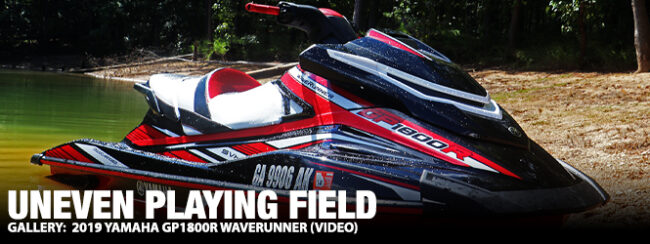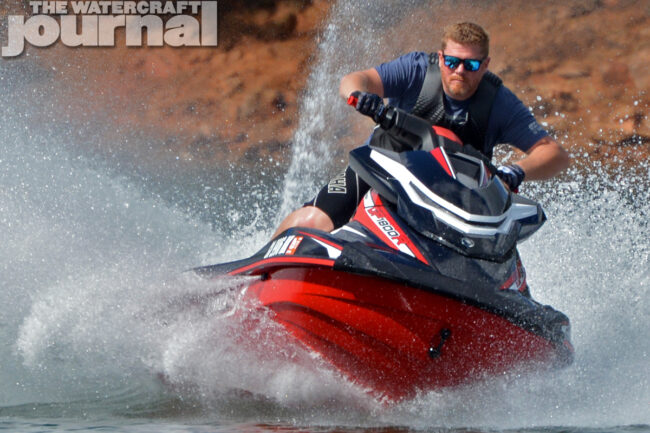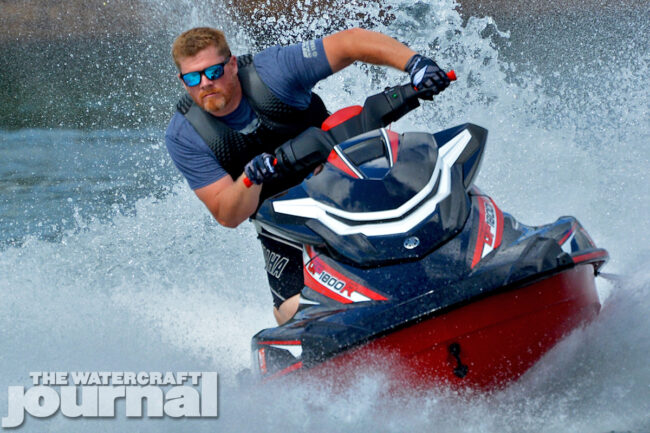I have come to the conclusion that the 2019 Yamaha GP1800R WaveRunner – much like the two years of the GP1800 that preceded it – is far too much of a machine for most people. Now, don’t get me wrong. There are plenty who think that they’re experienced enough, physically fit enough or “hardcore” enough to wring every last ounce of enjoyment out of the new GP1800R. They’re sure of it, just like an overconfident contestant strutting onto the stage of a talent show. They’ve been told by their friends and family that, yes, their talent and skill is above and beyond the norm.
Then comes someone or something that reveals how truly unpolished, untalented or unfit they truly are. No, the judges say, you can’t hit the notes like Whitney Houston. Sorry, but your friends were wrong. You’re not that good. And like those judges, the GP1800R is exactly the watercraft to provide the sobering revelation that no, you can’t ride like Chris MacClugage. That no, you’re not as “extreme” as you thought you were. The GP1800R will humble you. It is the equalizer. The leveler. It brings balance back to the Force.
Yamaha’s 769-pound, centrifugally-supercharged SVHO powered runabout is a stripped-down, factory-built race ski. There are very few “frills” – if they can even be called that. The intuitive dual-throttle RiDE on-water brake and reverse system, electric trim control, a folding swim step and some pretty cool two-tone Hydro-Turf mats are pretty much it. The GP1800R is not some heavy, cushy cruiser. If you want something to soak up the bumps over a nice, leisurely ride, Yamaha literally sells three different WaveRunners with the word “Cruiser” in their name.
Now yes, I guess you could cruise the GP1800R if you really wanted to. You could even tow the kid on a raft behind it thanks to a standard tow eye and 3-passenger rating. And yes, the 18.5-gallon fuel cell and 24.6-gallons of storage gives you plenty of capacity to load up enough go-juice and gear for a full day’s ride. But then you’re really not using this machine for its intended purpose – like welding a trailer hitch to the back of a ZR1 Corvette or hitching a plow to a racehorse. The GP1800R is a race ski after all. It was built for maximum performance. Don’t confuse it for anything but.
No current machine can equal it either around the closed course or out in the open ocean. Two years of regional, national and world championships can back this claim. The world’s top athletes are unstoppable on the GP1800 (and now the GP1800R), and the evidence is simply too overwhelming to combat. And being a professional racer doesn’t matter; few craft respond better to the rider’s natural talent and athleticism than the GP1800, or punishes for the rider’s lack thereof.
Similarly, there are few machines more responsive to aftermarket tuning and modification than the GP1800R. While companies like RIVA Racing, WORX and Greenhulk would like to sell you several thousands of dollars in performance parts, it’ll cost you about $1,200 to hit 81 miles per hour on 93 octane pump gas reliably. And we mean 81mph all day long. Want to see 85? It’ll cost you a little less than double that number. (Remember when hitting 80mph used to cost about $10,000?) And priced at $14,199, the $200 price jump from last year’s $13,999 doesn’t even cover half the cost up upgrading an old GP1800 to an “R”, so there’s that too.
At three-quarter-or-more throttle, the GP1800R tracks through chop sniper-straight, streaking over the surface linearly. In conjunction with very intuitive, responsive steering, it’s aquatic adhesion is accomplished by the addition of a sharply-angled top loader intake grate. The grate’s pitched blade forcing the intake flow up against the ceiling of the pump tunnel, feeding the top of the prop, producing consistent thrust and increased traction. New reinforcements to the inside of the pump tunnel also add increased strength.
A new aftermarket-inspired, bow-rise reducing ride plate keeps the GP1800R brutally hooked, whether carving glass or maneuvering through grueling open ocean at speed, and far more reliably than any runabout I’ve ever seen from the Yamaha Motor Corp., USA. The experience of wide-open-throttle riding in such conditions is not for the faint of heart or the feeble of hull design. A lesser shape can result in erratic or unpredictable tracking, bow steering or nose plowing. Never so with the GP1800R.
Despite this, I’m interrogated with, “how does it handle?” It’s a race ski, I reply. Or “how is it in chop?” It’s a race ski. And “how does it…” It’s a race ski! The GP1800R’s featherweight NanoXcel2 hull and deck are strong, ever-so-slightly forgiving but more importantly, communicative. You will know through your feet and hands what is happening beneath you. For the casual rider, that can become irksome. To the performance enthusiast, that trait is imperative. Let me give an illustration:
Years ago, I was able to drive a 800-horsepower Dodge Viper ACR. At first, I was appalled at how the American Club Racer (ACR) drove. It bounced ferociously across the road, it’s stiff springs chattering over every rise and dip in the asphalt. My first response was to hate it. But as I drove out onto the open track, everything made sense. The rigid suspension and “twitchy” steering became natural, communicating how the Viper wanted to maneuver. When driven right, it was perfect. Frankly, I wasn’t as good of a driver as I thought I was. The Viper ACR revealed that to me.
So no, I’ll say right now that the GP1800R is not for everyone. Admittedly, I may have played a part in confusing folks, as our crowning the 2018 GP1800 the “Watercraft of The Year” (for its second consecutive year) got many thinking it was the best “all around” PWC. Not so. We awarded it as “Watercraft of The Year” because it best accomplishes what Yamaha set out to do – and that was to build a true factory-built, 69.2 Garmin GPS-confirmed mile-per-hour race-ready ski.
Alas articles like these are supposed to whip up would-be buyers and set ’em loose in the direction of the nearest dealership to be welcomed by a friendly sales staff and promptly sold whichever watercraft I am currently reviewing. That’s what I’m supposed to do. Instead, I’m hoping to steer folks towards the ski that best suits their riding ability and intended use, which may or may not be a GP1800R. Of course, most will ignore my pleas, will merely scan this for exciting pictures and decide whether they want their new 2019 Yamaha GP1800R WaveRunner in Azure Blue with White or Black with Torch Red Metallic. And that’s OK too.








































